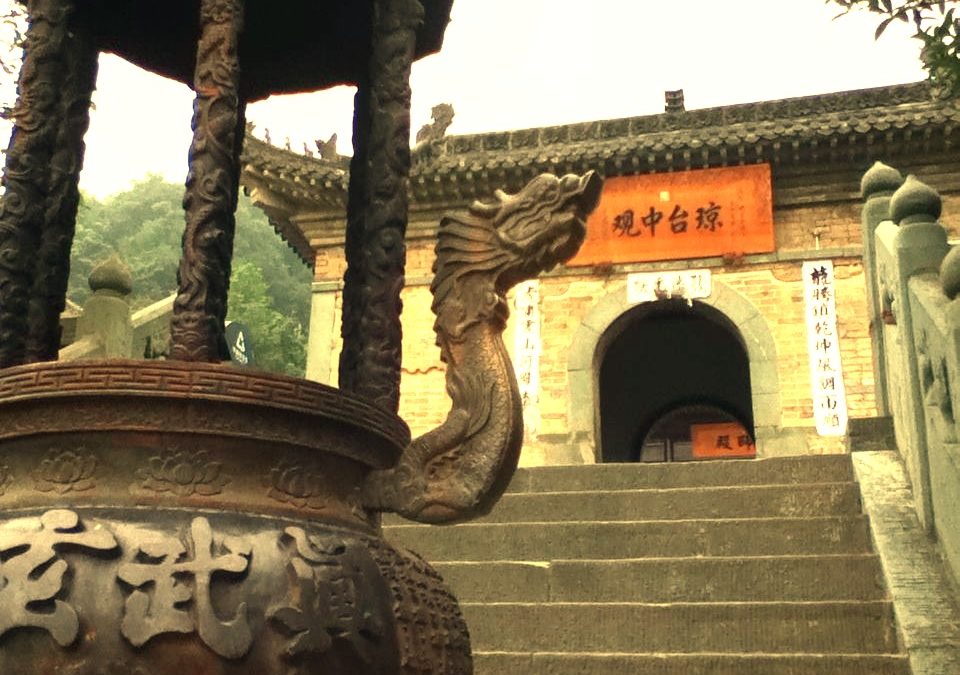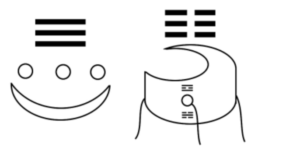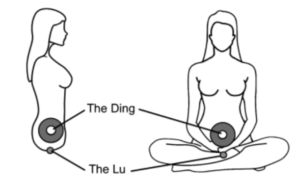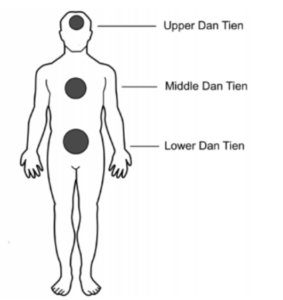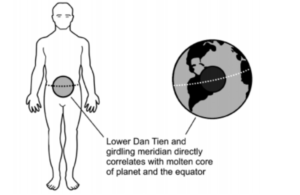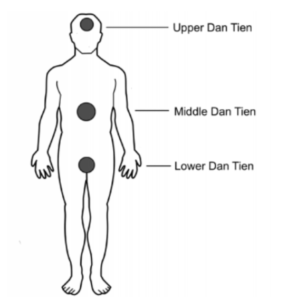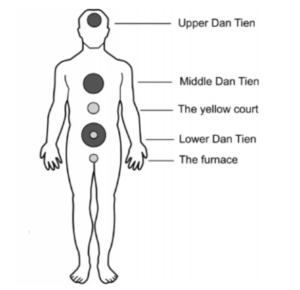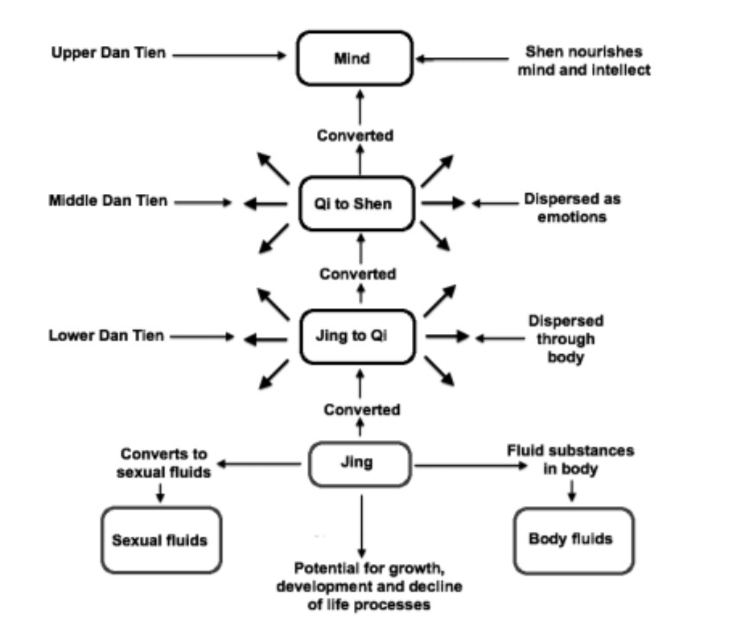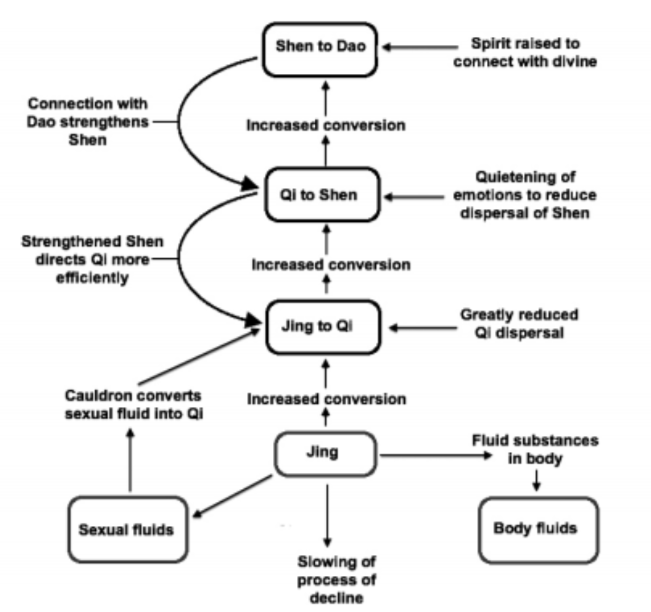The Ding and the Lu are two important regions of the energy body utilised within Daoist alchemical meditation. The Ding is the ‘cauldron’ whilst the Lu is the ‘furnace’ or ‘fire of cultivation’. When working with these aspects of our inner universe it is crucial that we develop an understanding of their location, function and the process of awakening them. If we look at the various arts and practices that have come out of the Daoist tradition we can see that each has it’s own terminology and unique ways of working. Understanding the nature of the Ding and the Lu is important to alchemical meditation whereas they are rarely discussed within less intricate practices such as Qi Gong.
The Ding is situated within the centre of the lower Dan Tien. Many think that the Ding is the lower Dan Tien itself but this is not the case. The lower Dan Tien is made up of numerous layers that can divide and rotate freely around each other like various layers on a gyroscope. This segmentation of the lower Dan Tien takes place as people move deeper into Nei Gong practice. It can be directly experienced as a series of individual rotations taking place within the lower abdomen. The size of the Dan Tien can also adjust according to the level of internal attainment of the practitioner. At highly developed stages it merges with the other energy centres of the body and three separate Dan Tien are no more, only Dan Yuan exists, the microcosmic manifestation of Hundun, original chaos. Unlike the various outer layers of the lower Dan Tien, the Ding continues to exist until such a time that, according to classical teachings, the body is totally dissolved into light; a state known as the attainment of the ‘diamond body’ within ancient teachings. When a person has achieved the state of Dan Yuan it is said that their entire energetic and spiritual field rotates as one unified whole rather than in separate rotational pathways as is the case for the majority of living beings. Obviously such high states of accomplishment are rarely achieved in modern or indeed times past; on top of this there is the added limitation to many people’s practice that their logical mind will not allow them to accept that such things are even possible.
The Ding is said to be roughly an inch in size for men with a woman’s Ding being slightly smaller (Those Daoist’s are very exact people when they keep records). It is the key place within which Jing is consolidated, Qi is converted and alchemically generated inner substances are immersed in order to ‘rebirth’ the spirit into its original state. This all takes place through controlled use of the breath and the Lu furnace. This process stimulates the Ding to generate an energetic catalyst for transformation.
Many of the esoteric teachings within Daoism are encoded within their architecture and artwork. Over the years as I have travelled to different temples and holy sites across Asia I have taken the time to examine the artwork closely. Teachers can manifest in many different places, not just within people you meet. Ancient art and architecture is a gateway to the past if you know how to read it. The image below is an example of a Ding respected as a cauldron in a Daoist temple:
The Ding is the body of the cauldron. These cauldrons are common in most Daoist temples and used to send offerings to the Heavens in the form of incense, magical offerings and even pretend money. They always stand upon three legs as shown. The number three represents the trinity of either: Jing, Qi and Shen, Body, Breath and Mind or Heaven, Man and Earth. These are the three powers that must be brought together in order to complete the alchemical process within the Ding in order to generate alchemical change.
When Daoist monks or nuns burn their offerings of incense within the centre of the Ding it sends smoke up into the sky. This is the spirit of the offerings moving up towards the Heavenly immortal realm. Microcosmically this is manifested as the movement of the spiritual energies upwards into the ‘Heaven’ of the body, the pineal gland and its energetic counterpart, the upper Dan Tien. This is the result of correct and efficient usage of the Ding and the Lu.
Classical Depiction of Ding and Lu
The above image shows the Ding on the right and the Lu on the left. The trigrams above the two symbols denote them as either extreme Yin or Yang. The process of alchemical transformation relies on the two opposing powers of Yin and Yang being brought together to form energetic union.
Within the body the Ding exists within the lower abdomen, as stated above, within the centre of the lower Dan Tien, whilst the Lu is the furnace which is essentially the energy around the region of the perineum. The image below shows the physical location of the Ding and Lu within the body.
The Ding and Lu within the Body
Initially, when starting out within alchemical training a practitioner will need to help the energy within the centre of the lower Dan Tien, the location of the Ding, to begin stirring. This is generally achieved through periods of silent sitting practice with the awareness gentle resting within this region of the body. It does not usually take very long for a practitioner to begin feeling the activity of the Jing and Qi within the region of the Ding. The resultant feeling is one of gentle heat within the lower abdominal region. This is generally accompanied by a gradual stilling of the mind as well as a feeling of contentment that is a direct result of the Jing and Qi within the lower Dan Tien having a stabilising affect upon the mind.
In the intermediate stages of practice, the breathing method is changed so that the perineum is gently raised upon inhalation. This brings the Ding and Lu together so that they have an energetic relationship with each other. The reaction is that the ‘furnace’ is lit and the alchemical reaction within the lower abdominal region increases. The feeling of heat becomes more tangible; there is also a clear sensation of movement that feels much like water bubbling and thus the foundations for alchemical practice have been established.
Within the Daoist tradition, understanding the nature and location of the Ding and the Lu was key to initiating alchemical change as well as beginning the conversion of the three treasures of Jing, Qi and Shen.
If we compare various lines of teachings from within the Daoist tradition we can see how different masters passed different methods onto their students. The variations in the methods being transmitted down through the generations within their school were largely due to the aims of their training. In contemporary Qi Gong schools we can still see today two main models of understanding with regards to how the energetic system works. Each of these models provides a different conceptual outline of the Dan Tien locations. As a student in China I was initially confused by these differences of opinion as I was training with teachers from both lines. Of course each teacher claimed that they had the correct and true transmission whilst my other teachers were mistaken. It was only once I moved deep enough into the alchemical processes of Daoism that I begun to develop an understanding of why these differences had manifested within each teachers training. Firstly let us look at the two different models. Below shows the first and arguably most common model for the location of the three Dan Tien.
The Energetic Model
Here we have the lower Dan Tien situated, as stated above, within the lower abdomen. It’s location will vary from person to person for various reasons. These can include such factors as individual body shape and size, age and even geographical location. This is because the human body is a direct microcosmic manifestation of our outer environment. With regards to the lower Dan Tien, this can be seen as being like the molten core of our planet whilst the equatorial line is manifested within our body as the Dai Mai or ‘girdling meridian’. This meridian runs around our waist as shown below. It actually has several other minor branches which are not depicted but the main pathway of the meridian depicted is the line which has a direct relationship with both the equator and the lower Dan Tien.
The Equator, the Girdling Meridian and the Dan Tien
People living closer to the equator or even on it will find that the lower Dan Tien actually sits further up within the body whilst those living further from the equator will find the lower Dan Tien is situated lower down. This difference in distance is subtle but as a person who travels extensively it is very clear to feel how the Dan Tien shifts if you are practicing enough to be familiar with its general location. Directly below the lower Dan Tien should sit the perineum and an important meridian point known as Hui Yin. It is here that the alchemical Lu is situated. It is an important task for all practitioners of the internal arts to locate the lower Dan Tien early on in their practice, especially if the conceptual model shown previously is the model used within your system.
The middle Dan Tien sits within the centre of the chest at the height of your heart. Microcosmically this energy centre corresponds to the energy of the sun in men and the moon in women. Nourishing this area of the energy body through directly bathing the chest in either sun or moonlight is a common spiritual practice by many traditions including the Daoists. This is the emotional centre as well as the place in which the mind and our Qi interact with one another.
The upper Dan Tien sits within the centre of the head with the pineal gland being the physical anchor by which this energetic sphere attaches itself to the realm of manifestation.
I tend to refer to this common model of the three Dan Tien as the ‘energetic model’ as it tends to be used by Qi Gong and Nei Gong methods concerned with energetic movement, rotation and refinement. Commonly practitioners are aiming to nourish the body with an increase of Qi from the environment, circulate it more effectively through the body and then finally refine it upwards so that it nourishes the consciousness. There may be a number of variations on this theme but this tends to be the general theory behind those practices which utilise the ‘energetic model’. It is common within medical Qi Gong as well as spiritual Qi Gong and many Nei Gong systems.
The image below shows the second common model for understanding the location of the three Dan Tien.
The Alchemical Model
In this model, the lower Dan Tien is situated right on the perineum itself. It is much smaller than the lower Dan Tien is seen to be within the ‘energetic model’ and its location is non-variable from person to person. The middle Dan Tien is situated within the centre of the body. This is a region of the body commonly known as the ‘yellow court’ and it corresponds to a meridian point known as Zhong Wan. If you wish to locate this area on yourself then measure four fingers width from the upper border of your naval as shown above. This will get you in the rough region; now palpate around a little until you locate a slightly tender region of the body. In many people there is a slight depression to be found as well. The upper Dan Tien, like the previous model, is located within the centre of the head.
I refer to this as the ‘alchemical model’ as it is the view of the energy body commonly used by systems of practice greatly influenced by Daoist alchemy. Unlike pure Qi Gong methods, alchemy aims to work with far more subtle and refined aspects of the body’s energetic substances. These ‘substances’ are drawn directly from the congenital region of our spiritual makeup. Practice at this level is complex and requires in depth instruction to ensure that any success is achieved.
As I mentioned earlier, whichever model is being taught, it is common for the teacher to state that theirs is the correct model. The fact is, both are correct, it just depends upon what your aims are in the practice. The confusion comes when both models use the same term, the Dan Tien, to discuss the energetic conversion centres they are focusing upon. In actual fact the term Dan Tien has become something of a general term for ‘gathering, refining and circulating’ regions of the energetic matrix when it should instead be referring to a specific function; that of storing and generating the ‘Dan’, the alchemical elixir sought out by generations of Daoist practitioners. If truth be told, a Dan Tien is not really a Dan Tien unless a person has actively reached the stage of generating the internal elixir, the alchemical pill which manifests at high levels of an internal alchemists practice. Prior to reaching this stage what you actually have is just a Tien, an energetic field which has the potential to interact with Jing, Qi and Shen in various ways depending upon how you use them.
In order to avoid confusion, when I teach, I use the common names of the three Dan Tien when discussing the energy centres shown in the ‘energetic model’. I then use the alternative, alchemical names for the centres shown within the ‘alchemical model’. When put together what we have is the combined model shown below. This is a model used within more esoteric systems of Daoist practices. These systems use a combination of Qi Gong, Nei Gong and Nei Dan in order to achieve their aims.
The Combined Model
In the combined model we can see that the lowest energetic centre is the Lu, the furnace. Above this is the lower Dan Tien with the Ding, the cauldron, at it’s centre. Above the lower Dan Tien is the yellow court and above this again is the middle Dan Tien. Situated within the centre of the head is the upper Dan Tien; the energetic centre agreed upon by almost all systems of practice.
With this model we can see how the Ding and the Lu interact with and function alongside the three Dan Tien.
The manner in which they work together will vary according to the stage a practitioner has reached. Within my personal teaching I generally take students through an early process using Qi Gong exercises, both moving and stationary. In this case the concerns are shifting energy through the body as well as purging the body of energetic toxins, a substance known as Xie Qi or ‘sick energy/information’. In order to do this more energy is brought into the body via the lower Dan Tien and then circulated through various orbits known commonly as the ‘microcosmic orbits’ or the ‘small water wheels’. The mind is calmed through deep rhythmic breathing and this helps to centre the middle Dan Tien. As the emotional centre starts to grow still this changes the quality of the Qi being circulated. It no longer carries with it the energetic debris of a person’s emotional high and lows. This is much healthier for the body and with continued practice a person will guide healthier energetic information to the various channels and organs of the body.
This establishes a foundation in good health. This is important for a person if they wish to progress steadily onto more alchemical practices. When they are ready to move on then they begin to work with the Ding and Lu in order to generate transformation with regards to how the internal system functions. If we look at the image below we can see how the body’s energetic circulation via the three Dan Tien takes place prior to the introduction of work with the Ding and the Lu.
Standard Energetic Circulation
In this instance the Jing, our essence, moves from the region of the Kidneys down towards the perineum where it starts to go through various natural processes. The first is the generation of body fluids including your sexual fluids. The second is the continuation or our ageing process. The Jing carries within it a seed of information, a kind of inbuilt code if you like that governs the speed and nature of how we age and eventually die. How fast we move through this process depends upon how efficiently we govern our inner processes and how well we look after our health. On top of this, of course, is natural strengths and weaknesses which are an inherent part of all of us. The third function for Jing to carry out is conversion into Qi when it is combined with the air we breathe and the food we eat. Essentially if we breathe effectively and eat healthy food then less Jing will be used in the creation of Qi but there will still always be a certain amount of our Jing being processed into Qi all of the time. This Qi moves upwards into the middle Dan where it converts into Shen and nourishes our intellectual mind. It is for this reason that many Qi Gong practitioners find that their mind grows calmer and more capable with regards to problem solving and similar functions.
During this process we lose energy through dispersal and emotional movements. More than anything our emotional swings and extremes drain us of the Qi we are converting from Jing each second.
Through practices such as Qi Gong we help to make this process more efficient and for many this can be life changing in itself. To be able to generate more energy within the body, feel more vitally charged and more centred in the mind is important on so many levels. Governing this process is the foundation of deeper work, alchemical work using the aspect of the energetic system shown within the ‘alchemical model’. Once we introduce the Ding and the Lu we have the ability to convert the body’s functioning over to the process shown in the image below. This is the beginning of true alchemical change.
The Alchemical Circulation
Through a combination of guidance from a teacher and perseverance a practitioner will be able to engage the process of the Ding and the Lu. As the Lu, the furnace, is ‘lit’ it starts to generate a change within the way that the Jing convert within the body. The interaction of the Lu with the Ding establishes the ‘cauldron’ of conversion within the centre of the lower Dan Tien and in this way the energetic substances of the body begin to ‘cook’. This changes the three processes of the Jing outlined above so that the following changes take place: Firstly the Jing still produces bodily fluids; this does not change. Secondly the ageing process begins to slow down and in many cases even reverse; nothing too extreme, you wont become an infant again, but it is common for thinning hair to become thicker and wrinkles on the face to fade away. It is within this process that the longevity of Daoist practitioners is to be found. It is true that even those who still live an ordinary length life tend to look a lot more youthful in their face than would be expected for their age. I will also let you in on a little secret here. Many people I met in China marvelled at the lack of grey hairs that their teachers had. Students would be amazed at 60-70 year old teachers without even a single grey hair on their head. The truth is that a lack of grey hair is often seen as a hallmark of Qi Gong mastery and consequently many Qi Gong masters in China dye their hair regularly so as to keep up the illusion! The third and most important change in the way that the Jing circulates is that more is converted upwards into Qi and this is added to by the essence contained within the sexual fluids. This essence is extracted by the actions of the Lu furnace and sent upwards to join the Jing being converted into Qi within the lower Dan Tien. The result of this is a far higher degree of vitality as well as a lessening of base sexual desires which were previously generated by the spiritual actions of the sexual fluids. This is an important aspect of the training for many practitioners as overcoming base desires is a serious hurdle to many internal processes.
The increased levels of Qi nourish the body to a far higher degree and this in turn generates a higher degree of Shen. Now instead of nourishing the intellectual mind it instead invigorates a persons deeper underlying consciousness. This is vital for spiritual evolution as a person’s true nature can begin to grow whilst the acquired layers of the mind begin to become less dominant.
This process of transformation must take place for serious practitioners of the Daoist arts as without this kind of work they will forever be stuck within the early, surface stages of their training. Of course, for many this is enough. Those who simply want a deeper level of relaxation and improved vitality, alchemical work is not required. But for those who wish to understand the deeper layers of Daoist transformational practices they must learn to govern and improve the efficiency of their internal processes. This largely requires understanding the conceptual models of the Daoist energetic system as well as the use of the Ding and the Lu.

